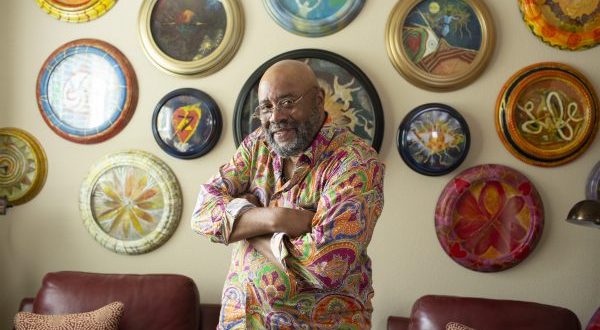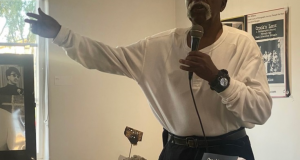By Rachel Griess
(EMPIRE NEWS NETWORK—ENN)— The Thorazine haze was beginning to fade when Glenn Towery was discharged from Oakland Naval Hospital. For the last however-many days he had felt listless, “like a non-human being,” making him forget why he was even there in the first place.
Before that, he occupied a hospital cot in the Philippines, next to an injured Marine who was asking about the weeping sores that covered his face and hands. “Where’d you get those Willie Peter burns?” he said — a question that burns into Towery’s memory.
He had been serving on the gunline in Vietnam as a quartermaster for the United States Navy — a ranking many on the ship did not take a liking to given it was 1972 and most other African Americans were low-rank deckhands. In fact, it was the first time Towery had been back on the ship since filing a complaint for the unjust discrimination and harassment he’d experienced.
He’d seen it all: racist graffiti drawn in sharpie all over his workstation; anger from other blacks who seemed less than impressed by his higher rank; an attack from behind that left him beaten, bruised, unconscious and alone.
“When you’re on a small ship, that becomes your world; and if your world is not a world where you feel welcome, it begins to play on you here,” Towery says, pointing to his head.
As a quartermaster, he had undergone months of intense training to navigate the ship and act as a watchman. But on the gunline, he was approached with new orders to “hump shells” and was given on-the-spot training. He spent the next few hours loading and firing as bullets whistled overhead, never thinking twice about the white powder on the shells he was loading.
“Someone tried to kill me,” says Towery, remembering his response to the injured Marine asking about the sores the white phosphorus powder had left on his skin, which begun “oozing out pus, and then crusting over.”
The realization angered him: “I kept replaying it in my head; innocently, not knowing what that powder was as I was working hard, sweating, still doing my duty.” He demanded, once again, to file charges, a request that the doctors ignored repeatedly, until he couldn’t take it anymore.
He pulled the IV out from his arm, slipped on a pair of foam slippers and took off across the field in nothing but his hospital smock. Behind him, military police rushed to stop him. But when they reached the commanding officer’s quarters, Towery “went berserk,” flipping tables, throwing chairs, and grabbing a letter opener, demanding his charges be filed.
By then, the police had drawn their service revolvers. Towery put down the letter opener, and they swarmed him, giving him a shot. He awoke in a daze, on a plane headed to the U.S., where he was transported to Oakland Naval Hospital and subjected to regular Thorazine shots.
It would be years before he could piece together his story through vivid, violent flashbacks and the information on his medical records. And it would be even longer still, until the Navy would recognize that the bouts of depression, hyperventilating and anxiety that left him debilitated, unable to hold down a job, was a “100 percent service-connected disability.”
After Vietnam, returning vets suffered from “Vietnam combat reaction,” but before that it was called “battle fatigue,” in World War II, or “shell shock,” in World War I. But by 1980, the infernal condition which Towery had been battling for years — at one point, driving him to homelessness — garnered a more permanent title: post-traumatic stress disorder, PTSD.
“I call it the feeling of dread. It’s the feeling something terrible is going to happen at any moment. And it swells up. And it grows. Can you imagine living like that for a month?” Towery says, describing his first-ever suicidal thoughts. “I just wanted it to stop.”
Every year, 6,000 veterans kill themselves — an estimated 20 deaths a day — making those who served 50 percent more likely to commit suicide than non-veterans, according to the latest report by the U.S. Department of Veteran Affairs. And PTSD heightens that risk.
“I understand what that feeling is that drives a lot of veterans to commit suicide, because I have been there,” says Towery, who created the Veterans Suicide Prevention Channel. “And I know that art is a great way to dispel that feeling. It’s a form of meditation. It’s a form of release.”
Today, Towery combats those feelings by painting clocks and portraits, playwriting, composing music and even creating and producing his own film, “Starfunk and the Astral Pioneers.” He’s also working to organize the first Austin Veterans Art Festival, which will feature performances by The University of Texas at Austin Warrior Chorus — a scholar-led workshop, sponsored by the National Endowment for the Humanities, that brings together veteran communities to study classical literature as it relates to contemporary America — in which he actively participates.
“Warrior Chorus helps you seek out what’s really important through studying the Greek literature, philosophy and characters,” Towery explains. “We are transfixed with these mythological tales that make us think that we are better persons if we experience these so-called glories. But what does it do? It just hardens you as a person.
“For instance, Ajax was a murdering fool,” Towery adds. “He just went out and started killing stuff, trying to figure out why he doesn’t feel anymore.”
Remembering how angry, how injured, how bitter, he was when he came back from war, Towery works every day to preserve the humanistic part of him that once felt so lost.
“My goal is to be whole before I die,” Towery says. “I know that may sound strange, but that’s my goal. I want to be the person who stepped up and said ‘I promise to defend my country, foreign and domestic. I will lay my life down for these United States.’”
Glenn Towery and the UT Austin Warrior Chorus will be performing at the Austin Veterans Arts Festival launch party on Nov. 15 (tickets required) and at the Austin Public Library Cepeda Branch at 6:30 p.m. on Nov. 20.
 Westside Story Newspaper – Online The News of The Empire – Sharing the Quest for Excellence
Westside Story Newspaper – Online The News of The Empire – Sharing the Quest for Excellence




